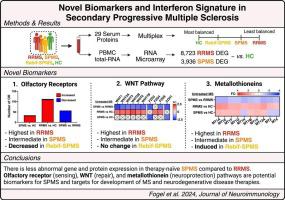当前位置:
X-MOL 学术
›
J. Neuroimmunol.
›
论文详情
Our official English website, www.x-mol.net, welcomes your feedback! (Note: you will need to create a separate account there.)
Novel biomarkers and interferon signature in secondary progressive multiple sclerosis
Journal of Neuroimmunology ( IF 3.3 ) Pub Date : 2024-03-06 , DOI: 10.1016/j.jneuroim.2024.578328 Avital Fogel , Maya Olcer , Aika Goel , Xuan Feng , Anthony T. Reder
Journal of Neuroimmunology ( IF 3.3 ) Pub Date : 2024-03-06 , DOI: 10.1016/j.jneuroim.2024.578328 Avital Fogel , Maya Olcer , Aika Goel , Xuan Feng , Anthony T. Reder

|
Multiple sclerosis (MS) exhibits poor immune regulation and subnormal interferon (IFN-β) signaling. Secondary Progressive MS displays waning exacerbations, relentless neurodegeneration, and diminished benefit of therapy. We find dysregulated serum protein balance (Th1/Th2) and excessive gene expression in Relapsing-Remitting MS vs. healthy controls (8700 differentially-expressed genes, DEG) and intermediate levels in SPMS (3900 DEG). Olfactory receptor genes (chemosensing), and WNT/ß-catenin (anti-inflammatory, repair) and metallothionein (anti-oxidant) gene pathways, have less expression in SPMS than RRMS. IFN-β treatment decreased pro-inflammatory and increased metallothionein gene expression in SPMS. These gene expression biomarkers suggest new targets for immune regulation and brain repair in this neurodegenerative disease.
中文翻译:

继发性进行性多发性硬化症的新型生物标志物和干扰素特征
多发性硬化症 (MS) 表现出较差的免疫调节和低于正常的干扰素 (IFN-β) 信号传导。继发性进行性多发性硬化症表现出逐渐减弱的恶化、持续的神经退行性变以及治疗效果的减弱。我们发现复发缓解型 MS 与健康对照(8700 个差异表达基因,DEG)相比,血清蛋白平衡(Th1/Th2)失调,基因表达过度,SPMS 处于中间水平(3900 DEG)。嗅觉受体基因(化学感应)、WNT/β-连环蛋白(抗炎、修复)和金属硫蛋白(抗氧化)基因途径在 SPMS 中的表达量低于 RRMS。 IFN-β治疗降低了SPMS中的促炎性并增加了金属硫蛋白基因表达。这些基因表达生物标志物为这种神经退行性疾病的免疫调节和大脑修复提供了新的靶标。
更新日期:2024-03-06
中文翻译:

继发性进行性多发性硬化症的新型生物标志物和干扰素特征
多发性硬化症 (MS) 表现出较差的免疫调节和低于正常的干扰素 (IFN-β) 信号传导。继发性进行性多发性硬化症表现出逐渐减弱的恶化、持续的神经退行性变以及治疗效果的减弱。我们发现复发缓解型 MS 与健康对照(8700 个差异表达基因,DEG)相比,血清蛋白平衡(Th1/Th2)失调,基因表达过度,SPMS 处于中间水平(3900 DEG)。嗅觉受体基因(化学感应)、WNT/β-连环蛋白(抗炎、修复)和金属硫蛋白(抗氧化)基因途径在 SPMS 中的表达量低于 RRMS。 IFN-β治疗降低了SPMS中的促炎性并增加了金属硫蛋白基因表达。这些基因表达生物标志物为这种神经退行性疾病的免疫调节和大脑修复提供了新的靶标。



























 京公网安备 11010802027423号
京公网安备 11010802027423号